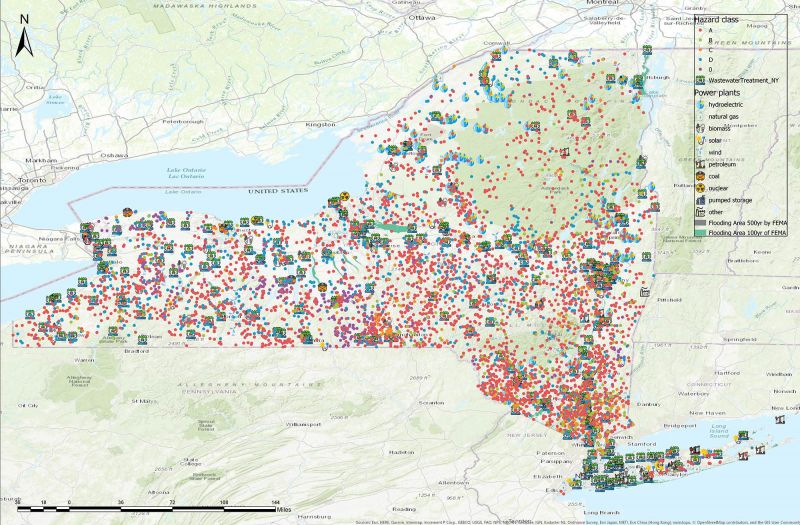Using Artificial Intelligence To Locate Risky Dams
Published on by Water Network Research, Official research team of The Water Network in Technology
In the U.S., 15,498 of the more than 88,000 dams in the country are categorized as having high hazard potential—meaning that if they fail, they could kill people. As of 2015, some 2,000 of these high hazard dams are in need of repair. With a hefty price tag estimated at around $20 billion, those repairs aren’t going to happen overnight.
BY SARAH FECHT

Caption: New York State areas and infrastructure at risk during rare but severe floods. Source: Byungjin So via ArcGIS, Via EI Columbia
A project out of the Columbia Water Center aims to help guide the process of repairing or decommissioning these dams. The team is pinpointing the riskiest dams, using climate models, GIS data, and artificial intelligence to predict the likelihood that rainfall will overtop a dam and cause significant downstream damages to population and critical infrastructure. “We can tell which dams should be repaired first, and which ones need to be monitored closely to plan for emergencies,” said Byungjin So, a postdoctoral researcher working on the project.
The work is particularly urgent as America’s dams continue aging and as climate change increases the chances of heavy rains and flooding. Most of these dams are now older than their original design life, and their condition is not always well monitored. Maintenance of these old dams is also a concern, as was shown by the near failure of the tallest dam in the country, the Oroville Dam, last year in California. The failure of the spillway led to the evacuation of 200,000 people as well as disruptions to the downstream water supply. The repair cost has now reached $1 billion, whereas prior maintenance and repair costs were estimated in the low millions of dollars.
A project out of the Columbia Water Center aims to help guide the process of repairing or decommissioning these dams. The team is pinpointing the riskiest dams, using climate models, GIS data, and artificial intelligence to predict the likelihood that rainfall will overtop a dam and cause significant downstream damages to population and critical infrastructure.
First Steps
The projections start with climate data. So works with climate models to understand atmospheric circulation and moisture patterns across space and time. In particular, he looks at winds that pick up water as they move across the Pacific Ocean on their way toward California. “For now we are only working with California,” explained So, “but later we will consider the whole U.S.”

The Columbia Water Center is analyzing the atmospheric circulation and moisture patterns that influence California’s precipitation levels. The line colors indicate specific humidity. Credit: Byungjin So
Next, he uses artificial intelligence to determine whether those moisture and circulation patterns will actually translate into rainfall. Analyzing data from 1980 to 2017, the A.I. is using deep learning to recognize which patterns typically lead to rainfall in California. It then categorizes an incoming weather system as “rain” or “no rain” with 95 percent accuracy.
Finally, So must predict whether the rainfall could lead to dam failure. He will use elevation maps, dam heights, dam storage capacity, and runoff calculations to predict whether the rain could overtop the dam. Meanwhile, demographic data will reveal the people and critical infrastructure that could be at risk downstream.
What Comes Next
For now, the A.I. only classifies weather events into wet or dry. Eventually, So wants to have it classify events with more detail, such as “low rainfall” and “high rainfall.”
In addition, he’s currently working on combining the artificial intelligence component into the climate model, and plans to finish that piece of the project in October. The assessment model for the dams, which is slated to be finished next year, will map the transportation, electricity generation, population and water/wastewater treatment infrastructure that could be impacted if each of the dams considered were to fail. Machine learning methods will also use rigorous simulations of dam failure dynamics from a few selected dams to project how any of the 88,000 potential dam failures could lead to downstream inundation and damage.
So hopes the model will be ready to advise decision-makers in the real world—and help protect people and infrastructure—by 2020.
Media
Taxonomy
- Technology
- Hydrography
- Hydropower
- Infrastructure
- Dams
- Integrated Infrastructure
- Urban Water Infrastructure
- Infrastructure Management
- Non Destructive Testing of Dams
- Water Software
- Internet of Things (IoT)
- green infrastructure
- AI